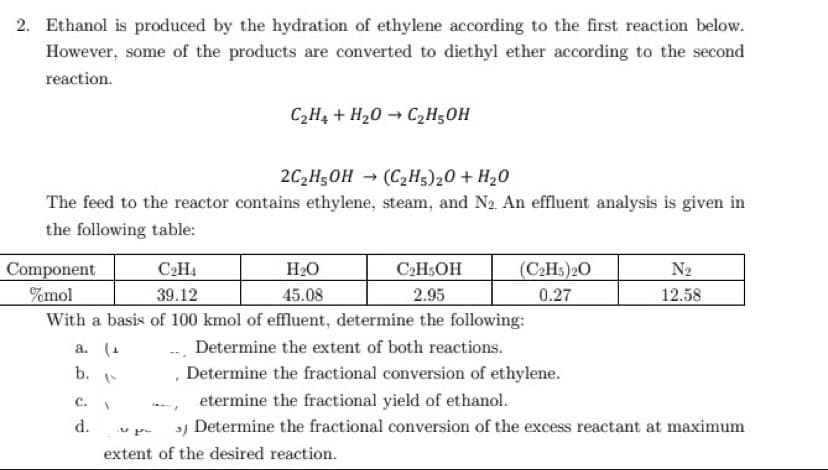2. Ethanol is produced by the hydration of ethylene according to the first reaction below. However, some of the products are converted to diethyl ether according to the second reaction. C2H4 + H20 → C2H;0H 2C2H50H → (C2H5)20 + H20 The feed to the reactor contains ethylene, steam, and N2 An effluent analysis is given in the following table: C2H4 (C2H.)20 Component %mol H2O C2H;OH N2 39.12 45.08 2.95 0.27 12.58 With a basis of 100 kmol of effluent, determine the following: a. (1 - Determine the extent of both reactions. b. Determine the fractional conversion of ethylene. с. etermine the fractional yield of ethanol.
2. Ethanol is produced by the hydration of ethylene according to the first reaction below. However, some of the products are converted to diethyl ether according to the second reaction. C2H4 + H20 → C2H;0H 2C2H50H → (C2H5)20 + H20 The feed to the reactor contains ethylene, steam, and N2 An effluent analysis is given in the following table: C2H4 (C2H.)20 Component %mol H2O C2H;OH N2 39.12 45.08 2.95 0.27 12.58 With a basis of 100 kmol of effluent, determine the following: a. (1 - Determine the extent of both reactions. b. Determine the fractional conversion of ethylene. с. etermine the fractional yield of ethanol.
Introduction to Chemical Engineering Thermodynamics
8th Edition
ISBN:9781259696527
Author:J.M. Smith Termodinamica en ingenieria quimica, Hendrick C Van Ness, Michael Abbott, Mark Swihart
Publisher:J.M. Smith Termodinamica en ingenieria quimica, Hendrick C Van Ness, Michael Abbott, Mark Swihart
Chapter1: Introduction
Section: Chapter Questions
Problem 1.1P
Related questions
Question

Transcribed Image Text:2. Ethanol is produced by the hydration of ethylene according to the first reaction below.
However, some of the products are converted to diethyl ether according to the second
reaction.
C2H4 + H20 → C2H50H
2C2H;OH → (C2H5)20 + H20
The feed to the reactor contains ethylene, steam, and N2 An effluent analysis is given in
the following table:
H2O
(C2HS)20
Component
%mol
C2H4
C2H5OH
N2
39.12
45.08
2.95
0.27
12.58
With a basis of 100 kmol of effluent, determine the following:
a. (1
- Determine the extent of both reactions.
b.
, Determine the fractional conversion of ethylene.
с.
etermine the fractional yield of ethanol.
d.
) Determine the fractional conversion of the excess reactant at maximum
extent of the desired reaction.
Expert Solution
This question has been solved!
Explore an expertly crafted, step-by-step solution for a thorough understanding of key concepts.
This is a popular solution!
Trending now
This is a popular solution!
Step by step
Solved in 7 steps with 7 images

Recommended textbooks for you

Introduction to Chemical Engineering Thermodynami…
Chemical Engineering
ISBN:
9781259696527
Author:
J.M. Smith Termodinamica en ingenieria quimica, Hendrick C Van Ness, Michael Abbott, Mark Swihart
Publisher:
McGraw-Hill Education

Elementary Principles of Chemical Processes, Bind…
Chemical Engineering
ISBN:
9781118431221
Author:
Richard M. Felder, Ronald W. Rousseau, Lisa G. Bullard
Publisher:
WILEY

Elements of Chemical Reaction Engineering (5th Ed…
Chemical Engineering
ISBN:
9780133887518
Author:
H. Scott Fogler
Publisher:
Prentice Hall

Introduction to Chemical Engineering Thermodynami…
Chemical Engineering
ISBN:
9781259696527
Author:
J.M. Smith Termodinamica en ingenieria quimica, Hendrick C Van Ness, Michael Abbott, Mark Swihart
Publisher:
McGraw-Hill Education

Elementary Principles of Chemical Processes, Bind…
Chemical Engineering
ISBN:
9781118431221
Author:
Richard M. Felder, Ronald W. Rousseau, Lisa G. Bullard
Publisher:
WILEY

Elements of Chemical Reaction Engineering (5th Ed…
Chemical Engineering
ISBN:
9780133887518
Author:
H. Scott Fogler
Publisher:
Prentice Hall


Industrial Plastics: Theory and Applications
Chemical Engineering
ISBN:
9781285061238
Author:
Lokensgard, Erik
Publisher:
Delmar Cengage Learning

Unit Operations of Chemical Engineering
Chemical Engineering
ISBN:
9780072848236
Author:
Warren McCabe, Julian C. Smith, Peter Harriott
Publisher:
McGraw-Hill Companies, The